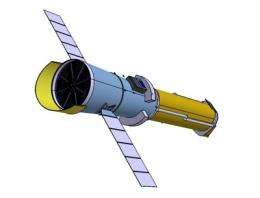Silicon technology offers extended X-ray vision of high-energy cosmos

(PhysOrg.com) -- As elements of the integrated circuits running our computers, phones and electronics, silicon wafers are everywhere. An ESA-led effort is establishing an out-of-this-world use for these commonplace items: when stacked together precisely by the thousand they promise to deliver astronomy?s clearest X-ray view yet of the most violent regions of space.
As elements of the integrated circuits running our computers, phones and electronics, silicon wafers are everywhere. An ESA-led effort is establishing an out-of-this-world use for these commonplace items: when stacked together precisely by the thousand they promise to deliver astronomy’s clearest X-ray view yet of the most violent regions of space.
“ESA has been working with specialist European firms to develop this new optical technique and build up a supporting industry,” said Marcos Bavdaz, Head of ESA’s Advanced Technology Section. “This ‘silicon pore optics’ effort is part of the Agency’s preparation for the International X-ray Observatory (IXO), a candidate mission with NASA and Japan’s space agency for around 2020.”
The Dutch company cosine Research is leading an international consortium of industrial partners and research institutes from ESA member states. This month, their latest results were presented: optics in flight configuration underwent testing in X-ray facilities, revealing excellent optical performance.

Hot secrets of the X-ray sky
Observing the sky in X-rays reveals a violent Universe of exploding stars, black holes and incandescent gas clouds. With temperatures of millions of degrees, such high-energy objects shine at X-ray wavelengths but not in visible light. Astronomers could only study this violent, high-energy Universe once the space age gave them a way of placing telescopes above the X-ray-absorbing atmosphere.
Actually forming a focused image from X-rays, however, is no easy task. Medical X-rays are well-known, but they are not focused images - just shadows cast through body parts using techniques pioneered by X-ray discoverer Wilhelm Roentgen in 1895.
Standard optical designs do not work because energetic X-rays are reflected only at extremely shallow angles. While visible light reflects off a mirror like a ball bouncing off a wall, X-ray reflection works more like a stone skimming along a pond. Telescope mirrors must face sideways instead of straight on, and many mirrors are needed to gather sufficient X-rays. So an X-ray telescope is more like a set of Russian dolls, with mirrors stacked around each other.
New technology for broader, sharper X-ray views
ESA’s XMM-Newton X-ray space observatory uses more than 250 gold-coated nickel mirrors, while NASA’s Chandra relies on fewer mirrors made of heavier glass. For IXO, the aim is to boost XMM’s collecting area 20-fold, while delivering three times the resolution. Achieving this demands new technology: while NASA is investigating an alternative called ‘slumped glass’, ESA is focusing on silicon pore optics, based around commercial silicon wafers.
ESA’s Eric Wille, overseeing the project together with Kotska Wallace, explained: “Manufacturers already polish these wafers to optical quality to better ‘print’ the tiny structures needed for the latest microprocessors. So the wafers need no further polishing, while also being both light and stiff.”
Semiconductor industry technologies are being harnessed to prepare silicon wafers and shape them into the complex structures required. They are cut into paper-thick square plates with ‘ribs’ diced into them to facilitate stacking. They are then tapered into a wedge shape to direct X-rays along the desired optical path, after which metal coatings are added. An industrial robot performs their precision stacking and mounting.
The technique is called ‘silicon pore optics’ because the massed stacks of ribbed silicon are porous, X-rays being able to reflect through each pore in the assembled silicon stack ‘petals’. IXO would need more than 200 000 silicon plates overall. The next step is to streamline the assembly process for mass production and further improve quality, opening the door to unprecedented discoveries in the X-ray sky.
Provided by European Space Agency
















